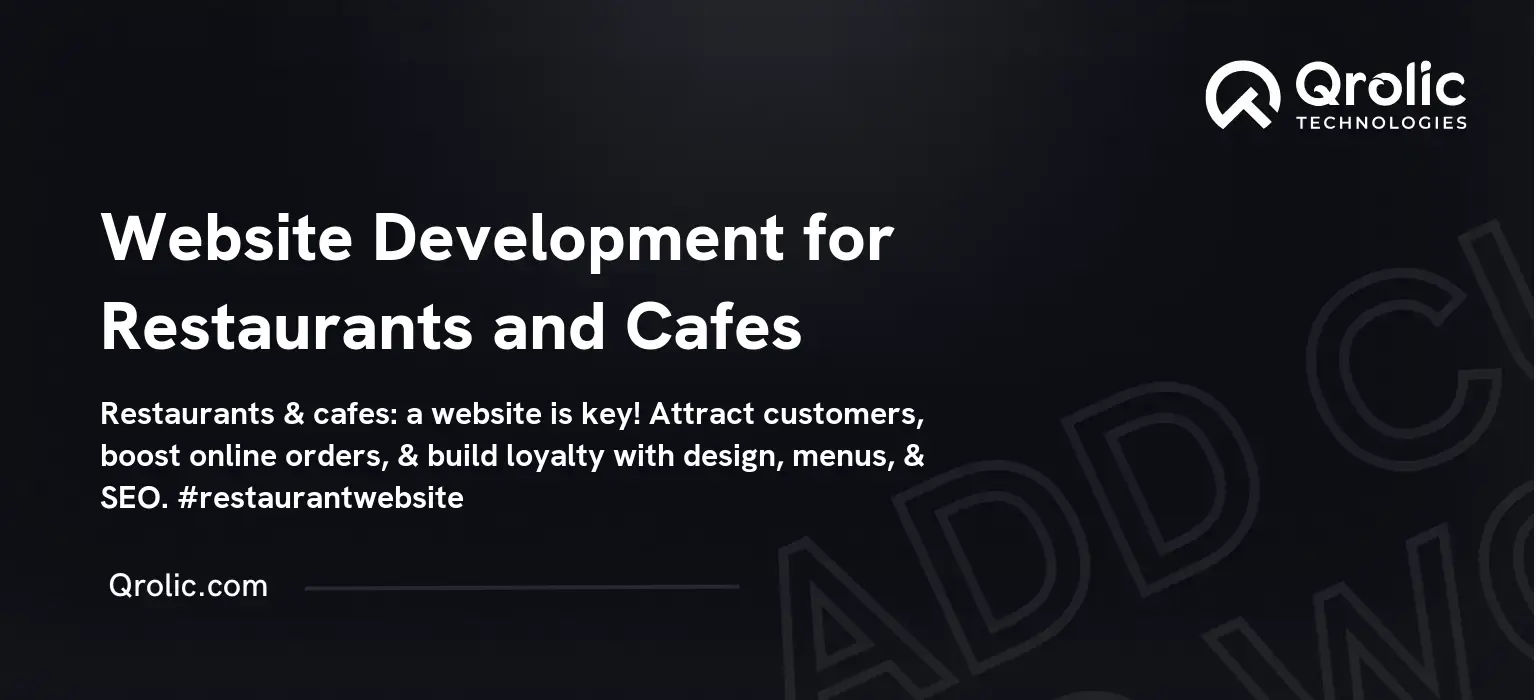Quick Summary:
- Plan your website goals and gather content.
- Choose a platform like WordPress and secure your domain.
- Add engaging content and optimize for mobile and search.
- Launch, promote, and regularly maintain your site.
Table of Contents
- Introduction: Brewing Success Online – Why Your Cafe Needs a Website
- Step 1: Planning Your Website – Defining Your Cafe’s Online Identity
- Step 2: Choosing the Right Platform – Website Builders vs. Content Management Systems (CMS)
- Step 3: Setting Up Your Domain and Hosting – Establishing Your Online Address
- Step 4: Choosing a Theme/Template – Designing Your Cafe’s Online Ambiance
- Step 5: Adding Content – Filling Your Website with Delicious Information
- Step 6: Implementing Essential Plugins & Features – Adding Functionality to Your Cafe Website (WordPress Specific)
- Step 7: Optimizing for Mobile – Ensuring a Seamless Experience on All Devices
- Step 8: Search Engine Optimization (SEO) – Making Your Cafe Website Discoverable
- Step 9: Testing and Launching – Ensuring a Smooth Takeoff
- Step 10: Promotion and Maintenance – Keeping Your Cafe Website Fresh and Engaging
- Bonus: Leveraging Social Media to Drive Traffic to Your Cafe Website
- Qrolic Technologies: Your Partner in Crafting Exceptional Digital Experiences
- Conclusion: Savoring Success – Your Cafe Website is Open for Business
Introduction: Brewing Success Online – Why Your Cafe Needs a Website
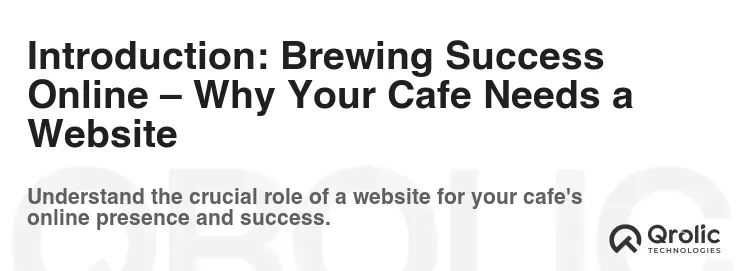
Let’s face it: the aroma of freshly brewed coffee and the cozy ambiance of your cafe can only reach so far. In today’s digital world, a website is not just an option; it’s the digital storefront that extends your reach, attracts new customers, and builds lasting loyalty. Imagine someone searching for “best coffee near me” on their phone. Will your cafe appear? If not, you’re missing out on a significant slice of the pie.
A cafe website is more than just a digital brochure; it’s a dynamic platform to showcase your unique offerings, tell your story, and connect with your community. It’s about capturing the essence of your cafe and translating that warmth and appeal into an engaging online experience.
Why should your cafe invest in a website? Consider these compelling reasons:
- Increased Visibility: Dominate local search results and make it easy for potential customers to find you. (Keywords: cafe website creation, coffee shop web design)
- Enhanced Brand Awareness: Create a strong online presence that reflects your cafe’s personality and values.
- Direct Customer Engagement: Build relationships with customers through online ordering, loyalty programs, and social media integration.
- Showcase Your Menu & Specials: Tempt visitors with mouthwatering photos and descriptions of your signature drinks and dishes.
- Online Ordering & Delivery: Expand your reach and revenue streams by offering convenient online ordering and delivery options.
- Share Your Story: Connect with customers on a deeper level by sharing your cafe’s story, mission, and values.
- Promote Events & Workshops: Keep your community informed about upcoming events, workshops, and special promotions.
- Collect Customer Feedback: Gather valuable insights to improve your offerings and enhance the customer experience.
- Cost-Effective Marketing: A website is a cost-effective marketing tool that can generate leads and drive sales.
- Competitive Advantage: Stand out from the competition by offering a superior online experience.
Ultimately, a well-designed and effectively managed cafe website can be a game-changer, driving more traffic to your physical location and boosting your bottom line.
Step 1: Planning Your Website – Defining Your Cafe’s Online Identity

Before you dive into the technical aspects, take a moment to envision your ideal cafe website. What message do you want to convey? What actions do you want visitors to take? This planning phase is crucial for creating a website that effectively achieves your business goals.
1. Define Your Target Audience:
Who are you trying to reach? Are you targeting students, professionals, families, or a specific demographic? Understanding your target audience will help you tailor your website’s design, content, and tone.
2. Determine Your Website’s Purpose:
What do you want your website to accomplish? Are you primarily focused on attracting new customers, promoting online ordering, or building community engagement? Prioritize your goals and ensure that your website is designed to achieve them.
3. Map Out Your Website’s Structure (Sitemap):
A sitemap is a visual representation of your website’s pages and their relationships. This will help you organize your content and ensure a user-friendly navigation experience. Here’s a basic sitemap for a cafe website:
- Homepage: The main entry point to your website, showcasing your cafe’s highlights.
- Menu: A comprehensive listing of your drinks, food items, and prices.
- About Us: Share your cafe’s story, mission, and team.
- Location & Hours: Provide essential information about your physical location and operating hours.
- Online Ordering (Optional): Integrate an online ordering system for convenient takeaway or delivery.
- Events & Specials: Promote upcoming events, workshops, and special offers.
- Gallery: Showcase enticing photos of your cafe’s ambiance, food, and drinks.
- Contact Us: Provide a contact form, phone number, and email address.
- Blog (Optional): Share engaging content about coffee, food, and your cafe’s community.
4. Gather Essential Content:
Start collecting the text, images, and videos you’ll need for your website. High-quality visuals are especially important for showcasing your cafe’s atmosphere and offerings. Think professional photos of your drinks, dishes, interior and happy customers.
- Menu Descriptions: Write compelling descriptions of each item on your menu, highlighting their unique ingredients and flavors.
- About Us Story: Craft a compelling narrative that tells the story of your cafe’s origins, mission, and values.
- Location Information: Provide accurate and up-to-date information about your address, phone number, and operating hours.
- High-Quality Photos: Invest in professional photography to showcase your cafe’s ambiance, food, and drinks.
- Customer Testimonials: Gather positive reviews and testimonials to build trust and credibility.
5. Consider Your Brand Identity:
Your website should reflect your cafe’s brand identity, including your logo, colors, fonts, and overall style. Consistency is key to creating a cohesive and memorable brand experience.
Actionable Tip: Create a mood board with visual elements that capture the essence of your cafe’s brand. This will serve as a visual guide during the website design process.
Step 2: Choosing the Right Platform – Website Builders vs. Content Management Systems (CMS)
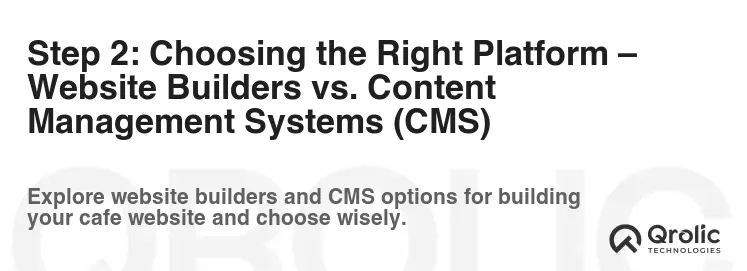
Now that you have a clear vision for your website, it’s time to choose the right platform to build it on. You have two main options: website builders and content management systems (CMS).
Website Builders (e.g., Wix, Squarespace):
- Pros:
- Easy to Use: Drag-and-drop interfaces make it simple to create a website without any coding knowledge.
- Affordable: Website builders typically offer affordable monthly subscription plans.
- All-in-One Solution: Website builders provide hosting, domain registration, and design templates in one package.
- Cons:
- Limited Customization: You may be restricted by the available templates and design options.
- Less Scalable: Website builders may not be suitable for complex websites with advanced features.
- Vendor Lock-In: Switching to a different platform can be difficult.
Content Management Systems (CMS) (e.g., WordPress, Joomla):
- Pros:
- Highly Customizable: CMS platforms offer a wide range of themes, plugins, and customization options.
- Scalable: CMS platforms can handle complex websites with advanced features.
- Open Source: CMS platforms are often open source, meaning you have more control over your website’s code.
- Cons:
- Steeper Learning Curve: CMS platforms require more technical knowledge to set up and manage.
- Requires Hosting & Domain: You’ll need to purchase hosting and domain registration separately.
- Maintenance Required: You’ll be responsible for keeping your CMS platform and plugins up to date.
Which Option is Right for Your Cafe?
- Website Builder: If you’re a beginner with limited technical skills and want a simple, affordable website, a website builder is a good option.
- CMS (WordPress): If you want a highly customizable, scalable website with advanced features, a CMS like WordPress is a better choice. WordPress is the most popular CMS in the world and offers a vast ecosystem of themes and plugins specifically designed for restaurants and cafes.
Recommendation: For most cafes, WordPress is the recommended platform due to its flexibility, scalability, and extensive library of plugins and themes tailored for the food and beverage industry. (Keywords: cafe website creation, coffee shop web design, easy steps)
Step 3: Setting Up Your Domain and Hosting – Establishing Your Online Address
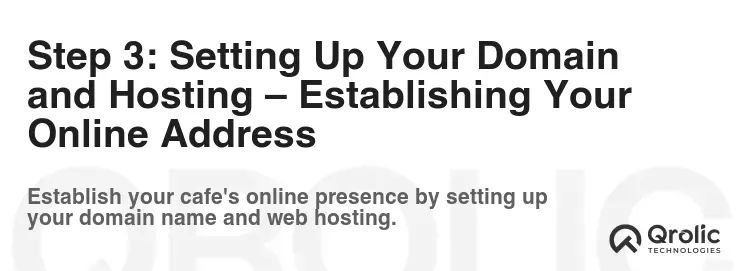
Whether you choose a website builder or a CMS, you’ll need a domain name and hosting.
Domain Name:
Your domain name is your website’s address on the internet (e.g., www.yourcafe.com). Choose a domain name that is:
- Easy to Remember: Keep it short, simple, and memorable.
- Relevant to Your Brand: Include your cafe’s name or a relevant keyword.
- Available: Check if the domain name is available before you register it.
- Use a Common Extension: Opt for a
.comextension if possible.
Where to Register Your Domain Name:
- GoDaddy
- Namecheap
- Google Domains
Hosting:
Hosting is where your website’s files are stored. Choose a hosting provider that offers:
- Reliability: Look for a provider with a high uptime guarantee.
- Speed: Choose a provider with fast servers and caching capabilities.
- Security: Ensure that the provider offers security features such as SSL certificates and malware protection.
- Scalability: Choose a provider that can accommodate your website’s growth.
- Customer Support: Look for a provider with responsive and helpful customer support.
Where to Find Reliable Hosting:
- Bluehost (recommended for WordPress beginners)
- SiteGround (renowned for WordPress hosting performance)
- WP Engine (managed WordPress hosting for high-traffic sites)
Connecting Your Domain and Hosting:
Once you’ve registered your domain and purchased hosting, you’ll need to connect them. Your hosting provider will provide instructions on how to update your domain’s DNS settings to point to your hosting server.
Actionable Tip: Choose a domain name that reflects your cafe’s brand and is easy to remember. Consider using a keyword related to coffee or your location in your domain name.
Step 4: Choosing a Theme/Template – Designing Your Cafe’s Online Ambiance

Your website’s theme or template determines its overall design and layout. Choose a theme that is:
- Visually Appealing: The theme should be visually appealing and reflect your cafe’s brand.
- Mobile-Responsive: The theme should be responsive and look good on all devices (desktops, tablets, and smartphones).
- User-Friendly: The theme should be easy to navigate and use.
- Optimized for Speed: The theme should be optimized for speed and performance.
- Customizable: The theme should be customizable so you can tailor it to your specific needs.
Where to Find Cafe-Specific Themes/Templates:
- WordPress: ThemeForest, TemplateMonster, Astra, OceanWP (search for “restaurant WordPress theme” or “cafe WordPress theme”)
- Wix: Wix Templates (search for “restaurant” or “cafe”)
- Squarespace: Squarespace Templates (browse the “Food & Drink” category)
Key Features to Look for in a Cafe Theme/Template:
- Menu Display: A visually appealing way to display your menu items.
- Image Galleries: A way to showcase high-quality photos of your cafe’s ambiance, food, and drinks.
- Online Ordering Integration: Compatibility with online ordering plugins or services.
- Reservation System: A way for customers to book tables online.
- Events Calendar: A way to promote upcoming events and workshops.
- Social Media Integration: Easy integration with your social media profiles.
- Contact Form: A simple and effective way for customers to contact you.
Actionable Tip: Browse demo versions of different themes/templates to see how they look and function before you commit to one. Pay attention to the overall aesthetic, user experience, and customization options.
Step 5: Adding Content – Filling Your Website with Delicious Information
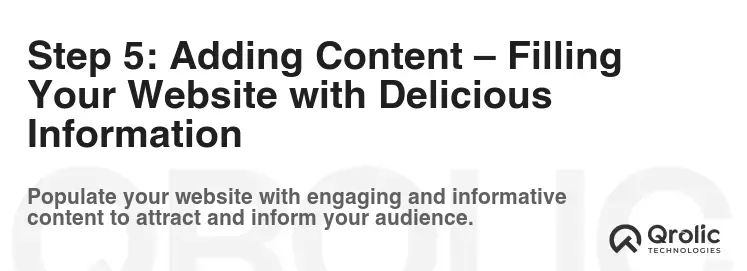
With your theme/template in place, it’s time to add content to your website. This includes text, images, and videos.
Essential Pages and Content:
- Homepage:
- Headline: A catchy headline that grabs visitors’ attention.
- Value Proposition: Clearly state what makes your cafe unique.
- Call to Action: Encourage visitors to take a specific action (e.g., “View Menu,” “Order Online,” “Find Our Location”).
- Featured Items: Showcase your most popular drinks and dishes.
- High-Quality Images: Use visually appealing photos of your cafe and offerings.
- Menu Page:
- Categorized Menu: Organize your menu into categories (e.g., coffee, tea, pastries, sandwiches).
- Detailed Descriptions: Provide detailed descriptions of each menu item, highlighting their ingredients and flavors.
- Pricing: Clearly display the price of each menu item.
- Allergen Information: Include allergen information for customers with dietary restrictions.
- High-Quality Photos: Use mouthwatering photos of your food and drinks.
- About Us Page:
- Cafe Story: Share the story of your cafe’s origins and inspiration.
- Mission Statement: State your cafe’s mission and values.
- Team Introduction: Introduce your team members and their roles.
- Cafe Philosophy: Explain your approach to coffee, food, and customer service.
- High-Quality Photos: Include photos of your team and cafe interior.
- Location & Hours Page:
- Address: Provide your cafe’s full address.
- Phone Number: List your cafe’s phone number.
- Operating Hours: Clearly display your cafe’s operating hours.
- Map: Embed a Google Map to show your cafe’s location.
- Parking Information: Provide information about parking options.
- Contact Us Page:
- Contact Form: Include a contact form for visitors to send you messages.
- Email Address: List your cafe’s email address.
- Phone Number: List your cafe’s phone number.
- Social Media Links: Link to your cafe’s social media profiles.
Content Optimization Tips:
- Use High-Quality Images: Invest in professional photography to showcase your cafe’s ambiance, food, and drinks.
- Write Compelling Headlines: Craft catchy headlines that grab visitors’ attention.
- Use Clear and Concise Language: Write in a clear and concise style that is easy to understand.
- Optimize for Search Engines: Use relevant keywords throughout your content to improve your search engine ranking. (Keywords: coffee shop web design, cafe website creation)
- Proofread Carefully: Proofread your content carefully for grammar and spelling errors.
- Keep Your Content Fresh: Regularly update your content to keep it fresh and engaging.
Actionable Tip: Create a content calendar to plan and schedule your website updates. This will help you stay organized and ensure that your website remains fresh and engaging.
Step 6: Implementing Essential Plugins & Features – Adding Functionality to Your Cafe Website (WordPress Specific)
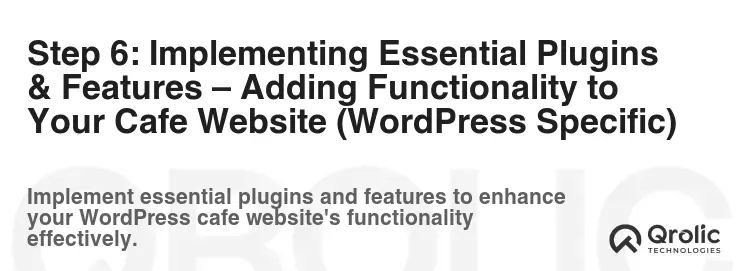
If you’re using WordPress, plugins are essential for adding functionality to your website. Here are some essential plugins for a cafe website:
- Contact Form Plugin (e.g., Contact Form 7, WPForms): Allows visitors to easily contact you.
- SEO Plugin (e.g., Yoast SEO, Rank Math): Helps you optimize your website for search engines.
- Image Optimization Plugin (e.g., Smush, Imagify): Compresses images to improve website speed.
- Caching Plugin (e.g., W3 Total Cache, WP Super Cache): Caches your website to improve loading times.
- Security Plugin (e.g., Wordfence, Sucuri): Protects your website from malware and hacking attempts.
- Social Media Plugin (e.g., Social Warfare, Monarch): Makes it easy for visitors to share your content on social media.
- Online Ordering Plugin (e.g., WooCommerce, GloriaFood): Enables online ordering for takeaway or delivery.
- Reservation Plugin (e.g., OpenTable, Resurva): Allows customers to book tables online.
- Events Calendar Plugin (e.g., The Events Calendar): Promotes upcoming events and workshops.
Essential Features for a Cafe Website:
- Online Ordering System: A seamless online ordering system that integrates with your payment gateway.
- Reservation System: An easy-to-use reservation system for customers to book tables online.
- Menu Management System: A system for easily updating and managing your menu.
- Blog: A blog to share engaging content about coffee, food, and your cafe’s community.
- Customer Reviews: A section to display positive customer reviews and testimonials.
- Social Media Integration: Easy integration with your social media profiles.
- Email Marketing Integration: Integration with an email marketing service to build your email list.
Actionable Tip: Research and choose plugins that are well-rated, actively maintained, and compatible with your theme. Avoid installing too many plugins, as this can slow down your website.
Step 7: Optimizing for Mobile – Ensuring a Seamless Experience on All Devices
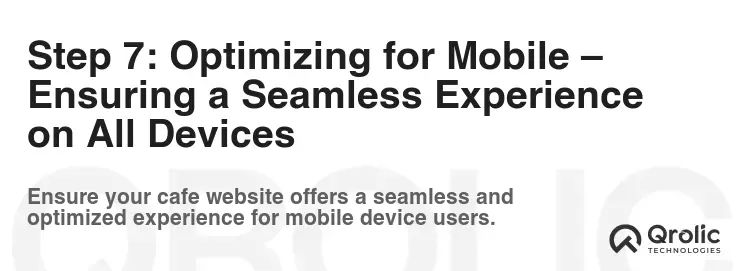
In today’s mobile-first world, it’s crucial to ensure that your website is optimized for mobile devices. This means that your website should be responsive and look good on all devices, including desktops, tablets, and smartphones.
Key Mobile Optimization Strategies:
- Choose a Mobile-Responsive Theme: Ensure that your theme is designed to adapt to different screen sizes.
- Optimize Images for Mobile: Compress images to reduce file size and improve loading times on mobile devices.
- Use Mobile-Friendly Navigation: Implement a mobile-friendly navigation menu that is easy to use on small screens.
- Ensure Readable Text: Use a font size that is easy to read on mobile devices.
- Avoid Flash and Other Obsolete Technologies: Flash is not supported on many mobile devices and can slow down your website.
- Test Your Website on Different Devices: Test your website on different mobile devices and browsers to ensure that it looks and functions properly.
- Use Google’s Mobile-Friendly Test: Use Google’s Mobile-Friendly Test tool to identify any mobile usability issues.
Why is Mobile Optimization Important?
- Increased Mobile Traffic: More and more people are using mobile devices to browse the internet.
- Improved User Experience: A mobile-optimized website provides a better user experience for mobile visitors.
- Higher Search Engine Ranking: Google prioritizes mobile-friendly websites in its search results.
- Increased Conversions: A mobile-optimized website can lead to increased conversions and sales.
Actionable Tip: Prioritize mobile optimization to ensure that your website provides a seamless experience for all visitors, regardless of the device they’re using.
Step 8: Search Engine Optimization (SEO) – Making Your Cafe Website Discoverable
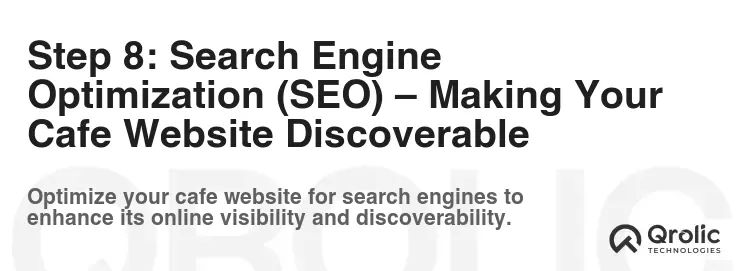
Search engine optimization (SEO) is the process of optimizing your website to rank higher in search engine results. This is crucial for attracting new customers to your cafe.
Key SEO Strategies:
- Keyword Research: Identify relevant keywords that your target audience is searching for.
- On-Page Optimization: Optimize your website’s content, title tags, meta descriptions, and headings with relevant keywords.
- Off-Page Optimization: Build high-quality backlinks from other websites to improve your website’s authority.
- Local SEO: Optimize your website for local search results to attract customers in your area.
- Content Marketing: Create high-quality, engaging content that attracts and retains visitors.
- Technical SEO: Ensure that your website is technically sound and easy for search engines to crawl and index.
Local SEO Tips for Cafes:
- Claim Your Google My Business Listing: Create and optimize your Google My Business listing to appear in local search results and Google Maps.
- Encourage Customer Reviews: Encourage customers to leave positive reviews on Google and other review sites.
- List Your Cafe in Online Directories: List your cafe in online directories such as Yelp, TripAdvisor, and Foursquare.
- Use Local Keywords: Use local keywords such as “coffee shop near me” or “cafe in [your city]” throughout your website.
- Participate in Local Events: Sponsor or participate in local events to increase your visibility in the community.
Tools for SEO:
- Google Search Console
- Google Analytics
- Yoast SEO (WordPress plugin)
- SEMrush
- Ahrefs
Actionable Tip: Focus on local SEO to attract customers in your area. Claim your Google My Business listing and encourage customers to leave positive reviews. (Keywords: cafe website creation, easy steps, coffee shop web design)
Step 9: Testing and Launching – Ensuring a Smooth Takeoff
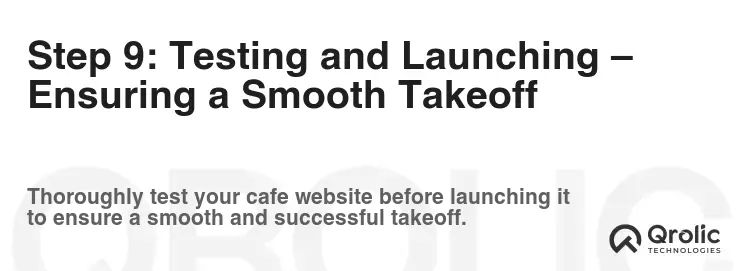
Before you launch your website, it’s essential to thoroughly test it to ensure that everything is working properly.
Key Testing Areas:
- Functionality: Test all links, forms, and buttons to ensure that they are working correctly.
- Responsiveness: Test your website on different devices and browsers to ensure that it is responsive.
- Speed: Test your website’s loading speed and optimize images and code to improve performance.
- Content: Proofread all content for grammar and spelling errors.
- Security: Ensure that your website is secure and protected from malware and hacking attempts.
Pre-Launch Checklist:
- Backup Your Website: Create a backup of your website before you launch it.
- Install Google Analytics: Install Google Analytics to track your website’s traffic and performance.
- Submit Your Sitemap to Google Search Console: Submit your sitemap to Google Search Console to help search engines crawl and index your website.
- Test Your Contact Form: Test your contact form to ensure that it is working properly.
- Check Your Legal Pages: Ensure that your website has the necessary legal pages, such as a privacy policy and terms of service.
Launching Your Website:
Once you’ve completed all of the testing and pre-launch checks, you’re ready to launch your website. Simply make your website live by changing your domain’s DNS settings to point to your hosting server.
Actionable Tip: Create a detailed testing checklist and thoroughly test your website before you launch it. This will help you avoid any embarrassing or costly mistakes.
Step 10: Promotion and Maintenance – Keeping Your Cafe Website Fresh and Engaging
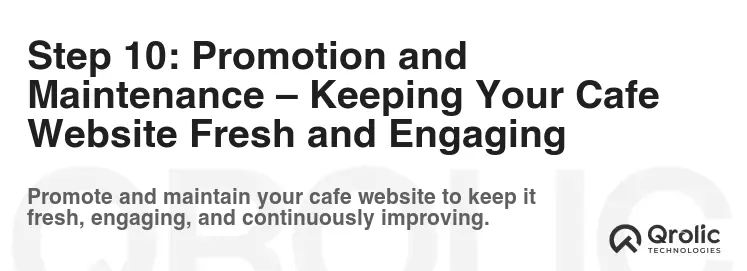
Launching your website is just the first step. To attract visitors and grow your business, you need to promote your website and keep it updated.
Website Promotion Strategies:
- Social Media Marketing: Promote your website on social media platforms such as Facebook, Instagram, and Twitter.
- Email Marketing: Build an email list and send out newsletters and promotions to your subscribers.
- Content Marketing: Create high-quality, engaging content that attracts and retains visitors.
- Search Engine Optimization (SEO): Continuously optimize your website for search engines.
- Online Advertising: Run online advertising campaigns on Google Ads and social media platforms.
- Local Partnerships: Partner with other local businesses to cross-promote each other’s websites.
- Print Advertising: Include your website address on your print advertising materials.
Website Maintenance Tasks:
- Update Your Content: Regularly update your website’s content to keep it fresh and engaging.
- Update Your Software: Keep your website’s software (e.g., WordPress, plugins, themes) up to date to ensure security and performance.
- Monitor Your Website’s Performance: Monitor your website’s traffic, loading speed, and security to identify any issues.
- Backup Your Website: Regularly backup your website to protect your data.
- Respond to Customer Inquiries: Respond to customer inquiries and feedback promptly.
Actionable Tip: Create a marketing plan and allocate a budget for promoting your website. Regularly update your website’s content and software to keep it fresh and secure.
Bonus: Leveraging Social Media to Drive Traffic to Your Cafe Website
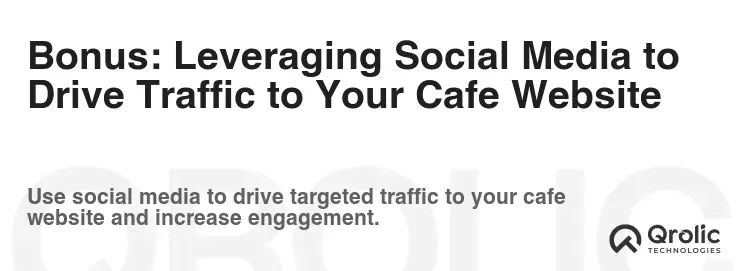
Social media is a powerful tool for promoting your cafe website and attracting new customers. Here’s how to leverage social media effectively:
- Choose the Right Platforms: Focus on the platforms that your target audience uses most. For cafes, Instagram, Facebook, and TikTok are typically the most effective.
- Create Engaging Content: Share high-quality photos and videos of your cafe’s ambiance, food, and drinks.
- Run Contests and Giveaways: Run contests and giveaways to attract new followers and generate excitement.
- Use Relevant Hashtags: Use relevant hashtags to increase the visibility of your posts.
- Engage with Your Followers: Respond to comments and messages promptly and engage in conversations with your followers.
- Promote Your Website: Include your website address in your social media profiles and promote your website in your posts.
- Run Social Media Ads: Run social media ads to reach a wider audience and drive traffic to your website.
- Collaborate with Influencers: Partner with local influencers to promote your cafe to their followers.
Actionable Tip: Create a social media strategy and schedule regular posts to keep your followers engaged. Use high-quality visuals and engaging content to attract new customers to your cafe.
Qrolic Technologies: Your Partner in Crafting Exceptional Digital Experiences

Creating a website is a journey, and sometimes you need a seasoned guide. That’s where Qrolic Technologies comes in. We understand the intricacies of building websites that not only look beautiful but also drive business results.
How Qrolic Technologies Can Help Your Cafe:
- Custom Website Design: We create bespoke website designs that perfectly capture your cafe’s unique brand and atmosphere.
- WordPress Development: We specialize in WordPress development, ensuring your website is scalable, secure, and easy to manage.
- E-commerce Solutions: We integrate seamless online ordering systems to boost your revenue streams.
- SEO Optimization: We employ proven SEO strategies to improve your website’s visibility in search results.
- Mobile Optimization: We ensure your website is fully responsive and provides a flawless experience on all devices.
- Ongoing Support & Maintenance: We provide ongoing support and maintenance to keep your website running smoothly.
Why Choose Qrolic Technologies?
- Expertise: Our team comprises experienced web developers, designers, and digital marketing specialists.
- Client-Centric Approach: We prioritize understanding your unique needs and goals.
- Results-Driven Solutions: We focus on delivering tangible results that improve your bottom line.
- Cutting-Edge Technologies: We leverage the latest technologies to create innovative and effective websites.
Ready to take your cafe’s online presence to the next level? Contact Qrolic Technologies today for a free consultation. Visit our website at https://qrolic.com/ to learn more about our services.
Conclusion: Savoring Success – Your Cafe Website is Open for Business
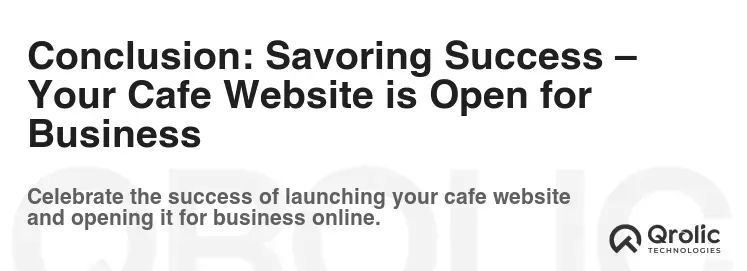
Congratulations! You’ve taken the necessary steps to create a cafe website that will attract new customers, build brand loyalty, and boost your bottom line. Remember that a website is an ongoing project. Continuously update your content, promote your website, and monitor its performance to ensure that it remains a valuable asset for your cafe. Now, it’s time to pour a cup of your finest brew and watch your online presence flourish! Remember to focus on creating a website that truly reflects your cafe’s atmosphere and values.
By following these easy steps, you’ve laid a strong foundation for online success. Your digital doors are now open, ready to welcome customers to experience the unique charm and delicious offerings of your cafe. Embrace the possibilities, stay adaptable, and watch your business thrive in the digital world!


